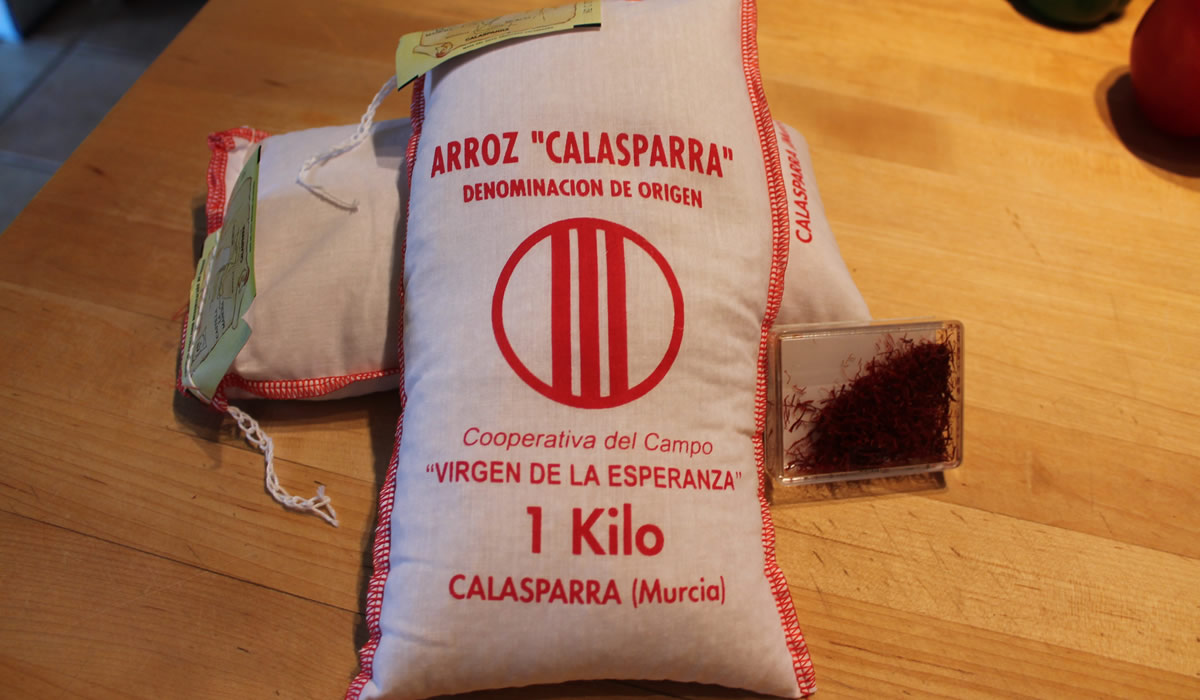In one week, we saw two different cooking shows on cooking paella. Not that I believe in omens or anything, but… It did put the thought in my mind. So much so, that I actually ordered authentic Calasparra rice from Spain. 2 kilos. I figured if I’m going to do this, I may as well do it right.
The Calasparra rice is a Denominación de Origen product, cultivated by hand in rice paddies along the banks of the Segura River. It’s fun to know exactly where your food comes from. I just hope they aren’t naming the individual grains…
It’s a really small-grain rice but it can absorb something like twice as much liquid as other rice while still maintaining its integrity. It’s not exorbitantly priced – about $8.00/kilo – and it’s rice. It has a long shelf life.
The program that really caught my attention was Jacques Pepin cooking paella. What I seriously like about him is his attitude that you’re making it – do what you want. Traditional foods have their place, but that doesn’t mean you can’t improvise. Paella, for example, was traditionally made with what was available at the time. It’s been traditionally seafood – but it doesn’t have to be.
He made his with chicken, chorizo, mussels, shrimp… added salsa and a commercial Alcaparrado – a mixture of olives, pimientos strips and capers.
I’ve actually never made a real paella in my life, and, I guess, technically, I still haven’t – but this is the closest I’ve come – and it was damned good! It didn’t have the perfect socarrat – the crispy bottom that is prized by paella-eaters everywhere – but I also didn’t make it in a traditional paella pan. Somehow, I doubt I’ll be buying one, either. One, I’m just not buying another single-use kitchen item. The second is I’m totally leery of burning the bottom of the paella. It’s walking a really fine line between crispy and carbon – and I’ve done enough carbon in my life. I just don’t need to do any more.
Jacques’ technique is not exactly traditional, either. He covers the pan for more uniform cooking. I did a bit of both – covered and uncovered – and I moved the pan around the flame every couple of minutes to get the bottom cooked more evenly. The end result was pretty good.
I really liked the rice. It’s smaller than the carnaroli rice I usually use for risotto and has great texture and flavor. I’ll bet it would make a great rice pudding, as well! And since I bought 2 kilos and only used about 200 grams, I have plenty left to play with!
Chicken, Chorizo, and Seafood Paella
- 3 tbsp olive oil
- 1/4 lb Spanish chorizo, diced
- 3small skinless chicken thighs, roughly chopped
- 1 cup coarsely chopped onion
- 1 tbsp coarsely chopped garlic
- 1 1/4 cups Calasparra – or other short grained rice, such as arborio
- 1/2 cup green pimento-stuffed olives
- 3 tbsp capers
- 1/2 cup chopped green pepper
- 1/2 cup chopped red pepper
- 2 tbsp hot sauce
- 1 cup canned diced tomatoes in sauce
- About 1 1/2 teaspoons saffron pistils
- 1 1/2 cups chicken stock
- 1 tsp salt
- 1 pound assorted seafood
Heat the oil in a large saucepan. Add the chorizo and chicken and brown over high to medium heat for 5 minutes, turning to brown on all sides. Add the onion, and garlic, and cook for 1 minute.
Add the rice to the pan and mix well.
Stir in everything but the seafood. Mix well and bring to a boil.
Cover, reduce the heat to low, and cook for about 12 minutes.
Add the seafood, placing them on top of the rice without stirring them in. Cover, increase the heat to medium, and cook for an additional 8 minutes.
Enjoy.
Since, like risotto, paella is really more about technique than it is ingredients, I can see some fun variations on a theme. Victor said he once had a vegetable paella recipe that called for artichokes, among other things.
We shall see…..






